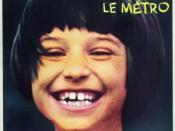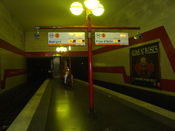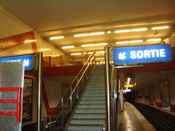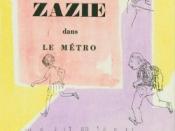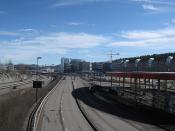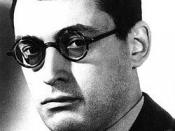Zazie in the Metro seems the most absurd term to describe Queneau's lexical choices; profane, irreverent, colloquial, farcical, fantaisiste are the terms that most readily come to mind. The author's expressed intention to rejuvenate the language of literature by introducing neofrancais or spoken language is manifest in the abundance of slang, puns, and phonographics mimicking the fusion of spoken words. Not uncommonly the most colloquial terminology is used with respect to serious subjects. Once vocalized, however, the impact of the informal terminology weakens under the rhythmic force of the poetry, its sonorous quality effectively canceling out the resemblance to everyday speech.
Always ready to inject a risqué association where it may least be expected, Queneau, the author of the novel Zazie in the Metro (1959), describes a heating machine that is also hot, if not hot to trot. As the sleeve emits a stream of yellow plastic beads, its fecundity emphasized by succeeding close-ups of blue, red, and green pearls, the film announces the fundamentally different agenda that distinguishes the eros of its mechanical devices from the bachelor machine of Duchamp and its thematics of unconsummated desire.
To subsume the totality of Queneau's work under the rubric "gender identity" and attempt to decode the corpus through a Pythagorean or Guenonian grid could be misleading, for the architectonics that characterize the early and late production appear to coincide with periods of intense spiritual quest or crises. Nevertheless, in the intervening years, during which Queneau is said to have succumbed to intellectual trends, mathematics continued to function as the scaffolding and sometimes the very focus of the work.
Gender identity and literature do not reveal a pre-given world but rather impose order upon a formless and inchoate flux by means of conventions of various techniques and genres. If this image of the writer as mechanical fabricator, wresting finished poems from the heavy machinery of literary history, anticipates the critique of the author launched by structuralists such as Barthes (who shortly would champion Zazie in the Metro), Queneau's embrace of the aesthetic of constraint would find its ultimate manifestation in his co-founding in 1960. Its members, including Georges Perec, Jacques Roubaud, Harry Mathews, Italo Calvino, and Duchamp, pursued with dizzying enthusiasm the imbrications of literature with mathematics and other formal systems.
The movie makes a crucial distinction in pointing out that the elements referenced are of Greek, not Far Eastern origin, citing the double references to Euclid and use of Platonic terms. Thus, we may conclude that Queneau's affinities with Chinese philosophy are just that--affinities and not a total embrace of Chinese thought. The appeal of the great themes of Oriental meta-physics--self-effacement or merging of the individual into the great harmony that is, the absence of distinction between past and future in favor of an temporal present, the resolution of contradictions by the notion of complementarily is the ease with which they can be assimilated within other traditions; one could incorporate these ideas without leaving Christianity. To conclude, however, that this mediation establishes the ultimate nonidentity of plastics with the organic is to overlook the violence immanent to the formation of matter itself that persists and obtains new and ever more frightening expression in the workings of technology, social organization, and the nation state.
ReferencesMotte, Warren, Jr. 2003. Raymond Queneau and the Aesthetic of Formal Constraint. Romanic Review.
Queneau, Raymond. 2001. Zazie in the Metro. New York: Harper Collins Pulishers.
Zazie in the Metro (Film). 1960. Astor Pictures
